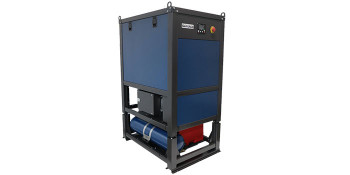Q&A Forums
R70 Ceiling? Post New Topic | Post Reply
| Author | Comments |
|---|---|
|
Thomas Kasper
Posted: Apr 29, 2007 09:17 PM
|
R70 Ceiling?
We get a few calls a year where customers want an unreal amount of insulation. We don't want to talk ourselves out of these jobs. So we give them a quote for the R value they want. The latest is a R70 ceiling. They want 6" ridgid foam then fiberglass batts (vaulted ceiling) The problem is it will be a double vapor barrier. I will suggest 6" ridgid foam and 10" open cell.Any problems with that? Thanks |
|
Edward Brassington
Posted: Apr 30, 2007 09:01 PM
|
I would suggest that you educate your customer about the true efficiency of foam. At 4 inches of two pound foam, you have achieved just about the maximum efficiency that you will ever obtain. There is a law of diminishing returns that is in effect, as in you don't gain any more efficiency. At the most, I would go to 5.5 inches, and that would be just to keep the uneducated building inspector happy. If you can show your customer how well your product performs, they will thank you for the huge amount of money that you saved them. You might loose extra cash on this job, but you will make up for it many times over on all the referrals that you will get. Also if you add 1/2 pound foam you are still creating a double vapour barrier. In my area building inspectors require vapor barrier on all half pound foam, I tend to agree with them on this. We have installed both the 1/2 pound and two pound and quite honestly if I never install 1/2 pound foam again it will be too soon. Do the right thing, educate your customer and you will both be a lot better off. |
|
SprayFoamSupply.com
Posted: Apr 30, 2007 10:01 PM
|
Installing .5lb foam over closed cell foam does not create a double vapor retarder, unless you put a separate vapor barrier over the open cell foam. I have had customers that want excessive amounts of foam, have the money, and don't want to learn about foam's superior efficiency. If 4" of foam is great, 8" of foam must be twice as great. Of course, try to educate the customer, but if he doesn't want to be educated, then remember the golden rule, the customer is always right! Even when he is wrong. George |
|
Gerry Wagoner
Posted: Apr 30, 2007 10:48 PM
|
The difference between 4" of rigid and 8" rigid is about 1% of efficiency. But they will pay 90% more to get that. I may be a hypocrite, I have R-63 in our cathedrals. 5-6" rigid, and 5-6" of dry packed cellulose. I did it because I could... The cellulose made it nice & quiet. Don't expect my customers to follow suit, they don't get the material at wholesale. :) olger |
|
Richard Russell
Posted: May 01, 2007 07:56 AM
|
"1% of efficiency" still can be a significant saving, depending on the structure and the goals of the owner. Speaking in percentages clouds the issue, because it leaves open the question: percent of what? Actually, in going from 4" to 8" CC @R6/inch, the saving in heat loss is 1/24 -1/48 or about 2% (but 2% of what?). Another way of looking at it is the heat loss would be cut in half - wow! But half of what is equally confusing. Certainly R24 of CC foam will be far better than "R38" of FG batt, but that is due to the poor performance of FG. Translating the nebulous "2%" or "half the heat loss" to a meaningfull number is easily done (using Q=A*delta T/R for a cold winter night or by entering the data for the whole house into the ResCheck software). In aiming for R70 in the roof, the homeowner may be aiming for superinsulated or at least Energy Star status and perhaps needs to compensate for some large window area by pinching wherever else he can. Is R70 overdoing it by any present measure? Sure, as I've seen in doing my own calcs for what I'll be building. But R24 (a real R24, not the bogus R24 of 8" FG) wouldn't even meet code in a cold climate, and in absolute heat loss terms isn't saving enough. R50 is about where I will be stopping. Given availability of space for insulation, it seem to me that CC foam is a very expensive way to get R50. When space is tight, then the much higher R/inch of CC shines. My opinion. YAMMV (and I hope to see more opinions on this high-R ceiling posted; I'm still hungry for information). |
|
Gerry Wagoner
Posted: May 01, 2007 07:45 PM
|
Thickness Cost to add [R] cost to heat Savings 1" 6.7 2000 ,,,,,,, 2" 500 13.4 1000 1000 3" 500 20.1 667 333 4" 500 26.8 500 167 5" 500 33.5 400 100 6" 500 40.2 333 67 7" 500 46.9 286 47 8" 500 53.6 250 36 |
|
Timothy Sonney
Posted: May 02, 2007 04:14 AM
|
Olger please forware me the breakdown that you have on this equation.... |
|
Posted: May 02, 2007 07:06 AM
|
...olger..me too...perrty please, ps..WTF is YAMMV??? hooked on phonics didnt work for me... |
|
Posted: May 02, 2007 08:19 AM
|
YAMMV = Your Actual Mileage May Vary! Tim Granite State Spray Foam Co. |
|
Richard Russell
Posted: May 02, 2007 09:28 AM
|
The heat loss is Q= U*Area*delta T, and R=1/U. So for 1" at R=6.7, for the Q to be 2000 BTU/hr, the product delta T * area is Q*R = 2000*6.7=13400. If the delta T is 70 F (cold night, zero outside), then the area used in Olger's tabulation is 13400/70= 191 sq.ft. If the 500 is $ per inch of foam, then at, say, $1.00/bd, the area used is 500 sq.ft, and the delta T is 13400/500 = 27 F. Either way, that is a small attic and a moderate climate, but scaling up for a different size and outside temperature is easy. The table and the underlying assumptions for $/boardfoot, area, and outside temperature, whatever they are, serve to point out how the actual incremental heat loss reduction vs. cost of getting it can be calculated, not guessed at. This is the type of calculation done by RESCheck and similar programs, adding up the heat losses over all parts of the outer shell for a whole house. It's not rocket science. If you can show the homeowner the numbers, then he'll believe and make his own assessment, according to his objectives. |
|
Posted: May 02, 2007 08:51 PM
|
thanx tim... dick,,,wasnt delta T a pro wrestler or sumpin?? (jk) |
|
Thomas Kasper
Posted: May 02, 2007 09:41 PM
|
According to the chart it looks like 7" is where it drops off to the point of deminishing return. imo. Obviously you get the most out of the first 4" So do we say anyone that wants more then 7" of cc is crazy? |
|
Richard Russell
Posted: May 03, 2007 01:20 PM
|
One final thought. The effect of the thermal bridging losses of studs and rafters is considerable in high R walls and roofs. For a 2x8 rafter @ R=1/inch and an R50 insulation layer (about the best a cc foam will do, or less, depending on claims made for the foam), the average R for the assembly will be only 36 for 24" oc rafters, or 32 for 16" oc. Still, compare that to the same 16" framing but using FG instead of foam. Even if the FG performed at the claimed R19 for a 6" batt, and the extra thickness were added to fill the 2x8 cavity, the effective R value for the FG + rafters would be only R19 (and the real world, zero-outside performance would be low teens!). |
|
Gerry Wagoner
Posted: May 03, 2007 10:14 PM
|
I'll do it tommorow, brethren. og |
|
Gerry Wagoner
Posted: May 03, 2007 10:16 PM
|
Russell, Roger Morrison provided me with the aforementioned chart. He's been around a little... Regards, oG |
|
Thomas Kasper
Posted: May 08, 2007 09:17 PM
|
Thanks for everyones input. I'm replying to foammaker comments... I'm just figuring out that the the building designer put so many windows in the building that "their" calculations call for a higher R-value. I suggest 6 in of cc but they don't want to spend the money. We are going to put three inches in the walls and two inches in the ceiling. They are going add fiberglass bats in the vaulted ceiling. Some people ya just can't tell em anything! They just do what they want. og, can you please send me that info on diminishing returns also. |
|
Timothy Sonney
Posted: May 11, 2007 12:19 AM
|
That high of an R-Value, Thermal Bridge, Termal Break, etc.... it seems like this customer wants foam to solve all issues.... all issues... foam can not do that.... the thermal bridge/break from the stud/rafter in contact with the exterior wall/roof... foam can't seal. Fiberglass can't seal it either, nor celly, or rockwool. You don't see an exoskeleton on the Shuttle do you? or the Super Dome. But Foam is the answer to the majority of the issues..... all of the issues if you ask me. Remember you only get one (1) chance to insulate, but you can always change your counter top, dishwasher, fridge, range, interior doors, etc.... Only the Smart ones will have the foam. The educated ones. The ones that look into the future of energy cost of the life of the structure. All we can do is continue to educate the conusmer, inspector, builder, etc.... Keep on foamin!! |





























